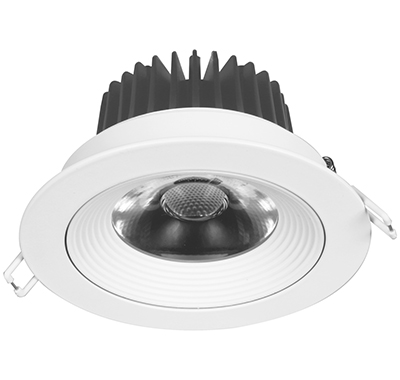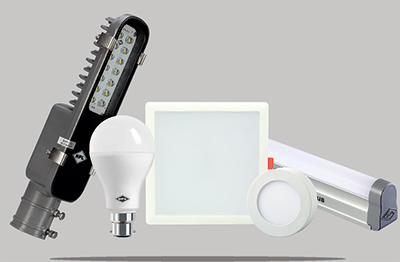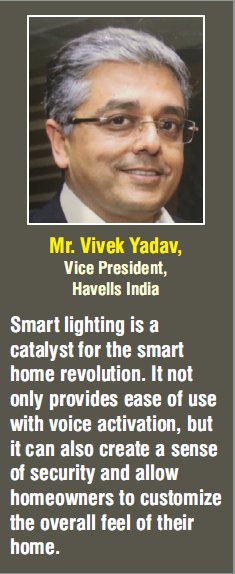The lighting industry is expected to reduce energy consumption for lighting from the present 18% of total power consumption to 13% by 2020 by introducing more energy efficient products and working more closely with the government to execute various schemes and awareness programmes.
 The Indian lighting industry is on a rapid growth path. The replacement of basic and inefficient incandescent, halogen, fluorescent lamps with modern LED lights will reduce electricity consumption. According to a report by ELCOMA, the lighting industry is expected to reduce energy consumption for lighting from the present 18% of total power consumption to 13% by 2020 by introducing more energy efficient products and working more closely with the government to execute various schemes and awareness programmes.
The Indian lighting industry is on a rapid growth path. The replacement of basic and inefficient incandescent, halogen, fluorescent lamps with modern LED lights will reduce electricity consumption. According to a report by ELCOMA, the lighting industry is expected to reduce energy consumption for lighting from the present 18% of total power consumption to 13% by 2020 by introducing more energy efficient products and working more closely with the government to execute various schemes and awareness programmes.
Mr. Gautam Seth, Joint Managing Director, HPL Electric & Power Ltd says, “Increasing consumer awareness about cost- effectiveness and eco-friendliness of LED lights has boosted LED lighting market that has amplified sales in the residential and well as commercial sectors. The industry saw a substantial decline in manufacturing and input cost, moreover new government policies has given a major boost to LED market. Furthermore, easy accessibility at affordable prices along with distribution of LED bulbs by government at subsidized rates to promote the use of LED lights over halogens and incandescent lighting products has enhanced the demand for LEDs in the country”.
 He adds, “Indian LED lighting market stood at $ 918.70 million in 2016 and has a vast scope for growth. The LED sector is expected to grow at a CAGR of 24.66 per cent, to reach US$ 3.76 billion by 2022. Key forces that are expected to boost led lighting industry market comprises of decreased LED prices, government initiatives, subsidization in installation projects etc. In addition to above awareness programs by manufacturers and regulatory bodies to educate consumers also plays a vital role in strengthening this industry”.
He adds, “Indian LED lighting market stood at $ 918.70 million in 2016 and has a vast scope for growth. The LED sector is expected to grow at a CAGR of 24.66 per cent, to reach US$ 3.76 billion by 2022. Key forces that are expected to boost led lighting industry market comprises of decreased LED prices, government initiatives, subsidization in installation projects etc. In addition to above awareness programs by manufacturers and regulatory bodies to educate consumers also plays a vital role in strengthening this industry”.
He further highlights, “The Government initiatives such as National LED Programme (2015) with objective of efficient lighting technology at affordable rates are one of the biggest factor of growth. The programme is divided into two schemes first, Unnat Jyoti by Affordable LEDs for All (UJALA) where, government aims to replace 770 million incandescent bulbs in households with LED bulbs and second, Street Lighting National Programme (SLNP) where government has set a target to replace 13.4 million conventional street lights with smart and energy efficient LED street lights by March 2019. Another special government scheme that is Modified Special Incentive Package Scheme (M-SIPS) offers incentives for the manufacturers of LEDs and other electronic equipment, wherein special incentive package is provided to promote large-scale manufacturing in the electronic system design and manufacturing sector”.
Lighting in the past
One of the biggest challenges that the lighting industry had faced was compatibility between control systems and LED fixtures because drivers needed special electronics. Now, with controls directly in the LED, you don’t have that compatibility issue. This is making it easier for homeowners to install smart lighting. Right out of the box, the fixtures can be installed as simple as replacing a bulb. It makes the process seamless.
The Present Lighting
According to MarketWatch, the millennial generation is at the forefront of the smart home revolution. In 2015, more than two-thirds of all adults aged 25 to 34 were living in wireless-only households. And according to a study by Nielsen, lighting control, at 70 percent, is the daily home automation feature most frequently used.
Smart lights appear on a short list of technologies beginning to appear on many buyers’ must-have lists because of its ability to improve security and comfort and cut electricity costs, according to MarketWatch. Smart lighting is just one piece of a total smart home revolution and is an easy entry point into the smart home. According to Gartner, it’s expected to continue growing to reach 2.54 billion units installed by 2020.
 Switches and push-buttons, for example, have become redundant. Instead, motion sensors have arrived. The light will automatically switch on when you enter a room. This is very useful when you come home with your hands full of groceries. Another benefit of smart lighting: the lamps switch off automatically when a room is empty. That’s one way of reducing your electricity bill.
Switches and push-buttons, for example, have become redundant. Instead, motion sensors have arrived. The light will automatically switch on when you enter a room. This is very useful when you come home with your hands full of groceries. Another benefit of smart lighting: the lamps switch off automatically when a room is empty. That’s one way of reducing your electricity bill.
Smart lighting also offers more convenience in other ways. Such as a change in color if it starts to rain, so that you can bring in the washing in time. Or a light pulse to replace the doorbell when the children are asleep. The possibilities are endless.
Leading brands are paving the way with smart LED bulbs and switches that connect to Wi-Fi and offer app, button and voice controls over the positioning, brightness, warmth and color of connected bulbs. The major technology behind smart connected homes is IoT and according to Strategy Analytics, IoT growth is higher than ever, but annual growth will begin to tail off as the market normalizes in the near future, dropping to 9 percent by 2021.
 In a study, it was found that most of the consumers are worried about the security of the home while they’re away. Smart homes have a solution for this too. Lights that come on at certain times of day, indoor and outdoor, give the illusion that you’re home and create a more secure environment. There are multiple ways to customize this, too. As a homeowner drives up to their home, lights can come on with Geofencing, or they can remotely use an app to turn lights on. It can be as simple as having lights on a timer, too.
In a study, it was found that most of the consumers are worried about the security of the home while they’re away. Smart homes have a solution for this too. Lights that come on at certain times of day, indoor and outdoor, give the illusion that you’re home and create a more secure environment. There are multiple ways to customize this, too. As a homeowner drives up to their home, lights can come on with Geofencing, or they can remotely use an app to turn lights on. It can be as simple as having lights on a timer, too.
Currently, smart tech is adapting to seamlessly integrate into smart home systems. Bluetooth-enabled systems that don’t rely on the internet need only the app and the fixture to operate. Even light switches may look completely different in 10 to 15 years. Homeowners are looking for a clean and sleek design. If you remove traditional light switches and replace them with a few smart home hubs that control multiple facets of a home, not just lighting, you can create a functional and efficient system.
The Future to Watch Out For
It is likely that the Indian lighting industry will continue to grow at a higher rate per annum, ranging between 13% and 15% until 2020. However, with a population of around 1.2 billion people, India is yet to provide electricity to around 0.3 billion people. If this section is connected to the grid, a further growth for the industry is on the cards.
On the home front, Smart wake-up and sleep lamps are the first step that tech companies have taken in using light to help consumers take their wellbeing into their own hands at home. Although research into using light and color for other purposes, like calming down, treating anxiety or aiding productivity is still limited – or needs to be applied in a very specific setting – researchers and tech companies will need to further switch on to this potential.
Andy Baxter at Philips Lighting predicts that the future of smart lighting is all about adapting to routines: “‘Human-centric lighting,’ where LED light can be tuned to positively help people, is likely to become a mainstream trend, whether it’s providing the optimum light setting to help someone to concentrate, energize or relax. It’s likely to be a hot topic in 2018 and beyond as businesses and consumers start to use it and the mental and physical benefits are explored in more depth.”
According to Mr. Gautam Seth, Joint Managing Director, HPL Electric & Power Ltd , “Smart solutions based on lighting infrastructure will play a major part in the planning of smart cities of the future. One of the key imperative of Smart City is better management of limited natural resources with a focus on increased environmental sustainability. Smart lighting solutions will lead to reduced energy consumption and lower consumption and maintenance costs, at the same time improving safety within the city”.
He adds, “Use of IoT (Internet of things) based smart lighting solution to perform wide ranging tasks would help city officials to monitor and take immediate actions. Sensors based smart lighting solutions could include street lights and lamp posts which would be used for increased public safety by creating an intelligent traffic management. Public safety, reducing street crimes, traffic and parking management are just a few benefits of the creating an IoT based networked smart lighting solution for smarter cities”.
Trends to Watch
Decentralized power generation
More than ever before, families are now producing electricity themselves, from solar panels. They are therefore less dependent on the power grid. That is also good news for the environment, because a photovoltaic installation produces green energy. This trend will continue to grow in the future, because the installation of solar panels is an interesting investment.
Lasers to replace LEDs
Scientists are continually looking for better lighting sources. Compared to LEDs, lasers provide the following benefits:
- More compact than an LED diode
- Produces up to 1000x more light
- Consumes 1/3rd of the electricity
This technology is currently still in its infancy. But there are already some promising projects, such as the laser headlights of the BMW i8.
Smart city lights
Smart street lighting could dim itself on empty streets in order to save energy. Or change color at dangerous intersections. With smart street lighting, maintenance technicians will know immediately when a lamp is faulty. Repairs will, therefore, be much quicker.
It is also possible to enhance street lamps with:
- Charging options for electric cars
- Wi-Fi modules to provide pedestrians with Internet
- Cameras to increase safety
- Sensors to quickly find free parking spaces
Trends outlined by Mr. Gautam Seth, Joint Managing Director, HPL Electric & Power Ltd, “Currently, metro cities generate larger demand for LED lighting, however in future this demand is expected to come from tier I and tier II cities especially on Industrial lighting and street lighting categories. Various consumer/commercial lighting devices are already enabled with LED such as Decor ball Glitz, Filament Lamp, Panel lightings, Luminaries, Street lights, Post top lanterns, CCMS, Spike lights etc, and there is a demand for LED technology in other devices as well”.






